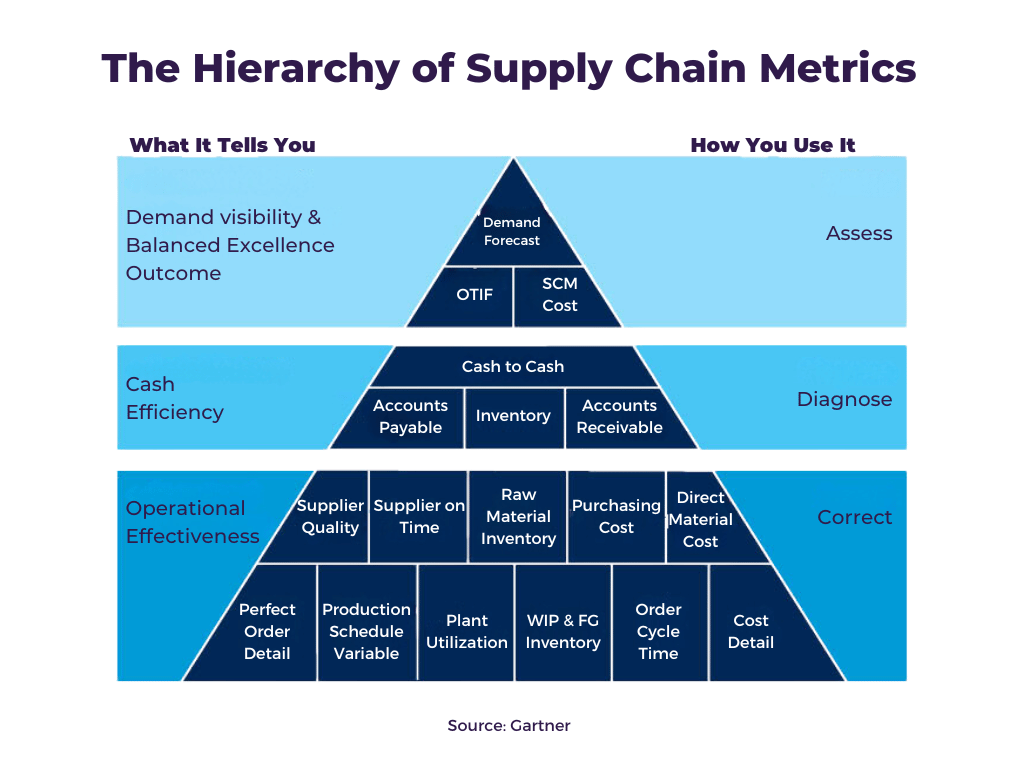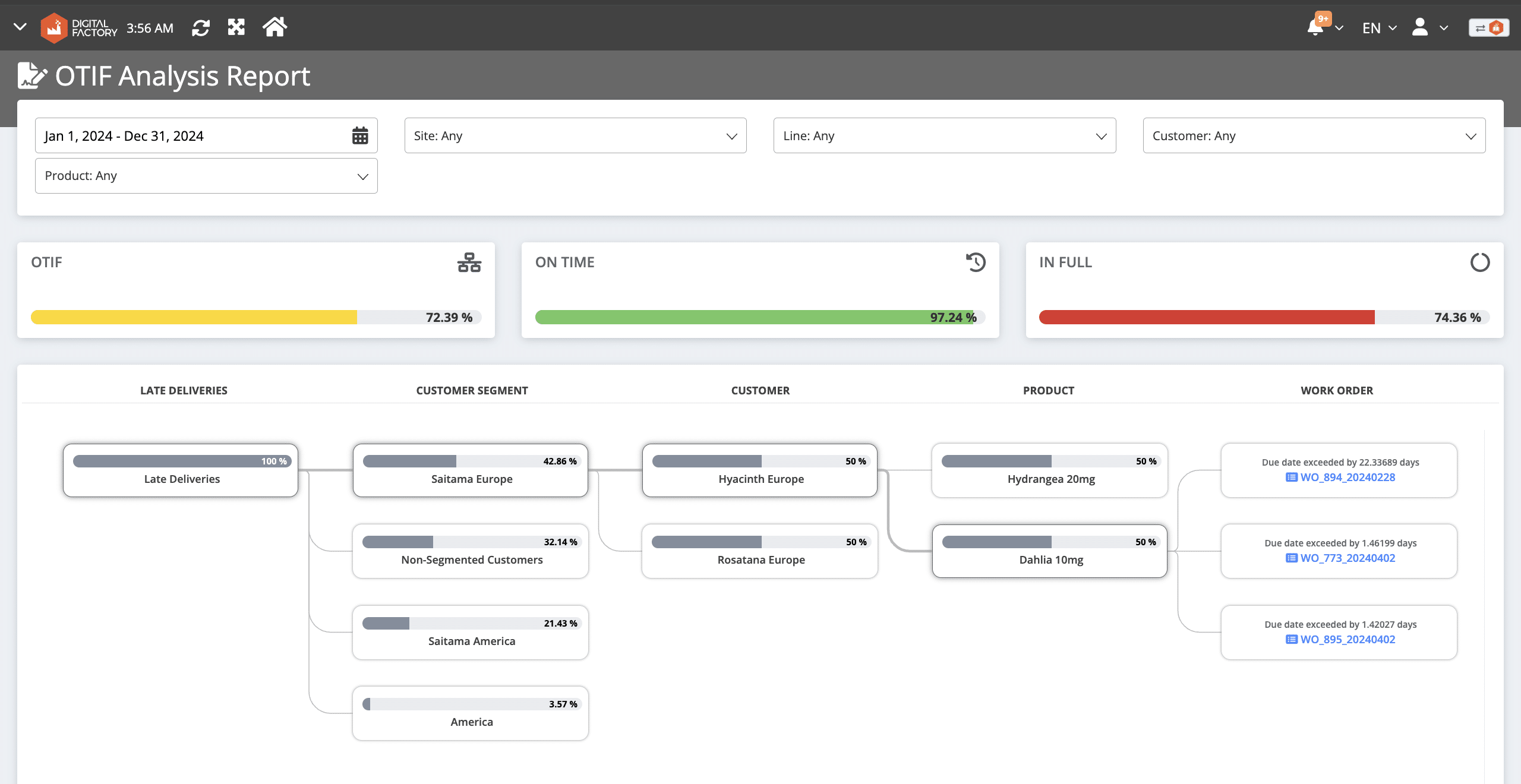
McKinsey reports that the post-COVID-19 era presents additional difficulties for supply chain managers, with over 50% of executives in CPG industries reporting higher OTIF expectations from retailers and OTIF fines for non-compliance.
In our quickly changing world where efficiency and accuracy are critical, the importance of OTIF cannot be undermined. However, calculation and utilization of OTIF as a key performance indicator (KPI) might pose a challenging issue for managers. To help executives gain a better understanding, we aim to clarify the concept of OTIF in this article, including:
- Definition of OTIF
- OTIF formula
- What does healthy OTIF mean for manufacturers
- OTIF best practices including ways SCW.AI can support you and more.
What is OTIF?
OTIF (on-time in-full) is a supply chain and manufacturing KPI that measures the successful completion and delivery of work orders. According to Gartner, OTIF is one of the top tier KPIs in the hierarchy of supply chain metrics that managers should take into account to assess the health of their manufacturing and supply chain.

OTIF has two components, which are:
1. On-time Delivery
Represents the extent to which your business fulfills or delivers work orders in scheduled time. On-time delivery calculation is; dividing the quantity of actual delivery meeting the due date requirements by the total demanded quantity within a specific time interval.
Consider a contract manufacturer handling multiple production deadlines for 1000 work orders spanning a specific timeframe. The on-time delivery KPI for this contractor achieves 85% when successfully delivering 850 work orders before or on their respective due dates.
2. In-full Delivery
Measure the good count of delivered/produced work orders to assess their compliance with the client’s quantity criteria, i.e., ordered quantity. To compute the in-full delivery metric, divide the total quantity of delivered work orders that meet the ordered quantity requirement by the overall number of work orders delivered within the specified interval.
Continuing with the previous example, the contractor’s in-full delivery KPI is 90% if it delivers 900 work orders with good counts successfully achieving or exceeding the initially specified quantities.
How to Calculate OTIF

The OTIF calculation is based on the number of work orders that are completed on time and in-full divided by the total number of work orders. OTIF is calculated in terms of percentage, where 100% implies perfect order. For this reason, businesses’ deviation from 100% is frequently taken into account when calculating OTIF penalties.
If we proceed with the earlier example, 800 out of 1000 items are delivered on time and in-full quality, meaning that the OTIF score is equivalent to 80%.
What Counts as a Good OTIF Score?
The measure of a flawless order rate is exemplified by achieving a 100% OTIF metric. Nonetheless, reaching this ideal score may prove unattainable, owing to a confluence of internal factors, including production disruptions raising from capital and labor inefficiencies, and external factors such as unforeseen pandemics, disasters, or even delays in the downstream supply chain.
On the other hand, companies continuously raise the bar for Good OTIF scores. According to Forbes, Walmart’s OTIF compliance in 2020 was determined to be 98%, up from 77% in 2017. Walmart is not alone in this tendency, as McKinsey notes, supply chain managers generally report higher OTIF expectations.
Greater OTIF expectations imply manufacturers must continuously improve their processes in a way they can reach higher OTIF scores to remain competitive in today’s business environment.
When to Incorporate OTIF as a KPI?

Especially contract manufacturers and CPG companies should determine OTIF as a KPI to:
- Pay Less OTIF Penalties: According to Forbes, OTIF fines for medium-sized businesses can easily range from $300k to $400k, meaning that for larger businesses, they could reach several million dollars. To ideally reduce fines to zero, you will need to start a program to increase your OTIF and measure it to see if it is in accordance with your goals.
- Ensure Client Satisfaction: Improved OTIF performance leads to satisfied clients, as it demonstrates a commitment to fulfilling agreements, ultimately enhancing the customer’s lifetime value.
- Determine Planning Inefficiencies: Your unsatisfactory OTIF score may be attributed to inadequate planning. For instance, if a commodity requires 30 days to produce when manufactured in 1000 units, scheduling it for only 20 days could lead to a lower OTIF score.
- Allocate Capital & Labor in a More Effective Way: Low OTIF ratings may also indicate that your worker productivity and overall equipment effectiveness (OEE) are not optimized, causing production to fall behind schedule. Hence, it can be said that an OTIF score can ultimately assist you in identifying production inefficiencies and taking appropriate action.
You can check our article World Class OEE in Pharma: A Benchmarking Analysis to learn about OEE average of pharmaceutical industry.
4 Ways to Improve OTIF for Contract Manufacturers

1. Get Real-Time Visibility
Achieving desirable OTIF performance for contract manufacturers begins with real-time visibility into their production processes. In today’s manufacturing landscape, one of the biggest challenges is obtaining real-time data. Without easy access to this critical information, measuring OTIF becomes difficult, and managers cannot improve what they are not measuring.
Implementing advanced tracking and monitoring systems can help you keep a close eye on the progress of your manufacturing operations. These systems allow you to capture and analyze real-time data on
- Production
- Inventory level
- And order status.
With real-time data at your fingertips, you can identify any potential bottlenecks or delays early on and take proactive measures to address them. Informed decisions and adjustments in real-time will ultimately improve your OTIF performance and enhance your overall operational efficiency.

2. Optimize Uptime
Efficiency is key when it comes to meeting OTIF goals. To improve OTIF performance, contract manufacturers should focus on optimizing manufacturing duration by:
- Streamlining production processes
- Reducing downtime
- And enhancing workflow efficiency.
By implementing lean manufacturing principles and leveraging technology like OEE Tracker, Labor Tracker and APS systems, manufacturers can minimize production lead times and increase their ability to meet customer deadlines.
3. Find Due Dates that Match Your Production Capability
Setting realistic due dates that align with your production capacity is essential for achieving OTIF targets. Avoid overcommitting to customers with tight deadlines that your facility cannot handle. Instead, assess your manufacturing capabilities and communicate transparently with clients to establish due dates that are feasible and reliable. This approach helps prevent disappointments and the need for expedited orders, ultimately enhancing your OTIF performance.
4. Know Your Clients’ OTIF Policy
Understanding your clients’ specific OTIF policies and requirements is crucial. Different customers may have varying expectations and demands regarding delivery times and order fulfillment. By being aware of their OTIF policies, you can tailor your manufacturing and supply chain operations to meet their unique needs. This proactive approach not only helps you meet client expectations but can also lead to stronger customer relationships and nurture repeat business.
How Can SCW.AI Improve Your OTIF
In the SCW.AI’s cloud based OEE Tracker module we provide the OTIF Report which provides instant data and insights regarding your OTIF score in the following granular level:
- Customer level
- Product level
- Work order level.
SCW.AI also produces Digital Factory tools such as Labor Tracker and Scheduler which can be complementary to OTIF Report to improve OTIF score. To find out more regarding our Digital Factory Solutions you can book a demo or contact with us:


